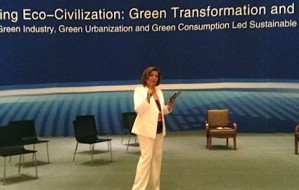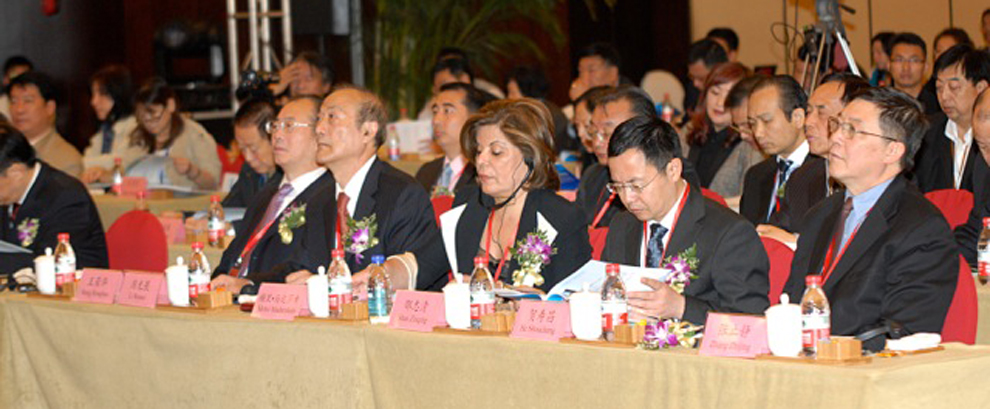
ECO FORUM GLOBAL, GUIYANG 2013
July 19, 2013
Speech by Mehri Madarshahi
Sustainable Development and role of Women Enterpreneurs
Sustainable development has been defined by the Brundtland Commission as “development which meets the needs of the present without jeopardizing the needs of future generations” This means economic growth that does not deplete irreplaceable resources, does not destroy ecological systems, and helps reduce some of the world’s gross social inequalities.
We are still far from achieving these goals. Today, between a fifth and a quarter of the world’s population live in poverty, without adequate food, clothing and shelter. 90 % of these people are in developing countries . Moreover, Population growth of nearly one billion in a decade, pollution and habitat destruction pose serious environmental problems which obligate all of us including business community- to take swift actions in dealing with these problems. Some examples of serious environmental problems are deforestation, destruction of coral reefs, introduction of aggressive new predators, and other human activities that are making many species disappear. If these trends continues unchecked, the future of mankind may be in a jeopardy.
Eco-efficiency emphasizing the need for more efficient use of energy and maximizing use of renewable resources may help solve many problems created by global warming including
pollutions and toxic substances, clean water and adequate sewage disposal ,….
The world-wide adoption of eco-efficiency by Government and now by businessmen and women is under way. While the business community can not solve some of these fundamental problems alone, The world-wide adoption of eco-efficiency by Government and now by businessmen and women is just under way. Evidence of the evolution of eco-efficiency from theory to practice and action is growing day by day
- More than half of the world’s largest companies now provide reports on environmental, social and ethical performance. In some OECD countries, such reporting is required. In Belgium, Denmark, France, the Netherlands and Norway, corporate sustainability reporting is a legal obligation, mostly linked to annual financial reports. Other countries require sustainability reporting from certain sectors, actively encourage information disclosure, and/or provide certification and verification services for companies of their environmental and social practices. But in most OECD countries, sustainability reporting is voluntary and reporting and compliance vary widely across sectors and companies.
- As production and sourcing take place on an increasingly global scale, the environmental and social dimensions of products are largely invisible to consumers. There are a growing number of codes of conduct and guidelines for promoting the sustainability of company values, practices and production processes to which more and more multinationals ascribe. However, corporate responsibility for the ecological and workplace conditions of their smaller suppliers and contractors along the global supply chain is still a vague area.
Eco –efficiency workshops have been conducted
International and national organizations are promoting awareness world wide
Important managerial manuals are being published by business community.
Environmental protection issues has already affected many business and is becoming increasingly a determinant of a company’s reputation among employees, customers, and stake holders alike. With industrial products and consumer goods flowing freely around the world, corporations are becoming increasingly aware that they have a stake in the economic health and development of all societies they do business with
Monosanto and 3 M are tow companies that have introduced zero emissions. Xerox Corporation has set the goal of waste-free products from waste-free factories. Dow has recently announced aggressive 10 years reduction goals for environmental performance and resource conservation
All those who are engaged in environmental advocacy know how fundamental it is to organize sustained
public awareness campaigns on preservation of water, forest and energy . Public education and popularization of these issues have become an indispensable tool to emphasize the point that economic development should not be at the expense of clean air and water and preservation of our natural heritage.
Although consumer choices are influenced by income levels, social conditions and biases, gender is also a major factor. In their consumption choices, women throughout their lives affirm their reproductive role and concern about the longer-term well-being of families and children How women entrepreneurs make a difference .
Women are increasingly visible in export-oriented sectors in middle income developing countries, where they comprise up to 90% of workers. Females now tend to dominate in low-skill, labour-intensive jobs in textiles, clothing, pharmaceuticals, household goods and toy production in non-OECD countries. Much of this employment is located in export processing zones, which account for between 33% and 88% of production and exports depending on the sector. In 2005, it was estimated that there were 50 million jobs in export processing zones worldwide and that 80% of these were held by women
- It is clear that women’s participation in inclusive, sustainable and green growth can propel the growth of a green economy. Women are consumers, they are also workers and producers, and in this context they play a crucial role in benefiting the growth of a green economy and in reaping the benefits from it.
- The Harvard Business review estimated that in 2009 women controlled roughly US$20 trillion dollars of global consumer spending, with a predicted rise to US$28 trillion by 2014. Studies also showed that economically empowered women are more likely to purchase goods for their households — specifically for their children, including food, healthcare, education, clothing and personal-care products; and simultaneously they are more likely to buy recyclable, eco-labeled and energy efficient products.
- So women’s economic empowerment affects patterns of household spending and is likely to increase demand for sustainable services and products. This trend could lead to significant impact on green growth.
- Studies also show that, if women’s paid employment rates were raised to the same level as men in the US, Euro-zone and Japan, Gross Domestic Product (GDP) would increase by 9 to 16 percent. Thus, economically empowered women are poised to propel a green economy.
- But women are also workers and producers and the potential of their participation in a “green labour force” should not be underestimated. Currently at least 80 percent of global green jobs are expected to be in the secondary sectors, such as construction, manufacturing and energy production — industries where women are currently under-represented. For example, women account for 9 percent of the workforce in construction, 12 percent in engineering, 15 percent in financial and business services, and 24 percent in manufacturing — all sectors critical to building a green economy.
- To fill this shortage, training is needed. While this entails a cost; the benefits are many. On the production end, women trained in research and development for environmentally friendly products can contribute to designs that have both women and men in mind, enhancing the marketability and use of such products. Ultimately this influences sustainable consumption patterns. A 2008 report covering 15 countries by Goldman Sachs stated that “greater investments in female education could yield a ‘growth premium’ that raises trend GDP by 0.2 percent per year.”
- International trade and investment have led to the globalisation of production where goods are made up of many component parts produced, assembled and shipped in different parts of the world. The sustainability of globalised production has become of increasing concern in terms of the environmental and social practices of multinational enterprises and their supply chains (OECD, 2008c). Of particular interest are the ecological impacts of production processes in manufacturing, agriculture, mining, forestry and other sectors through contributions to climate change, deforestation, overfishing and loss of biodiversity. The social practices of firms, including the health and safety of employees, labour representation, sustainable livelihoods, community contributions, and increasingly gender impacts are also under the spotlight.
- Entrepreneurs, or individuals starting up new firms, are crucial to productivity and growth in all countries. At present, new enterprise creation is fueled by the development of technology-based and service sectors. In the OECD area, levels of entrepreneurship are highest in countries showing the fastest growth. Women often become entrepreneurs out of a desire to exploit innovative ideas or market niches. The number of women entrepreneurs, as seen in female to male start-up ratios, is also growing fastest in these countries, which include the United States and Canada. the gender gaps are particularly large in Turkey, Ireland, Iceland, Sweden and Japan. Levels of female entrepreneurship are highest in Canada, Switzerland, the United States and Austria.
- In terms of resource impacts, women tend to leave a smaller ecological footprint than men due to their more sustainable consumption patterns. Sustainable consumption is using resources in a way that minimises harm to the environment while supporting the well-being of people. Impressing a more feminine footprint would result in a smaller impact on the environment as well as better access to goods and services that take into account the needs of both women and men. While it is estimated that women make over 80% of consumer purchasing decisions, men spend over 80% of household income, although this is changing as women gain more economic and marketplace power (Yaccato, 2007).
Surveys show that women tend to be more sustainable consumers. Women are more likely to recycle, buy organic food and eco-labelled products and place a higher value on energy-efficient transport (OECD, 2008a). They make more ethical consumer choices, paying closer attention to issues including child labour and sustainable livelihoods and are more apt to buy socially labelled goods such as Fairtrade. For example, in Sweden, statistics indicate that the group that is most concerned about eco-labelling and green purchasing includes some of the poorest members of society: single mothers. Women also use public transportation, even in households with cars, more often than men and travel short distances closer to home, while men more often travel in their own car and for greater distances
More and more companies are realizing that the best performance comes from staff or associates who share and commit to common values. 3 M, for example, bases its success on consistent application of four key values;
Satisfying customers with innovative products, superior quality and value providing investors with an attractive return
Respecting the social and physical environment
Being a company employees are proud to be part of.
Development must take due consideration of the constraint of our rich but fragile environmental base. Only through econ-efficiency and optimitization of human , capital and environment resources will we be able to offer all our people and future generation the hope of a better quality of life.
The business community must strive to be a leading model to bringing sustainable life style to all citizens and in all its facets of life. It should commit itself to brining electrical power to as many people as possible, to stimulate development and education and to raise the potential quality of life. We have already made good progress towards ensuring that schools, clinics, and other vital services are connected to reliable energy sources. We have to set target for rapid electifications of all home and ensure that electricity is generated from renewable sources of energy and become affordable.
Eco-efficiency is as valid for small businesses and developing countries as is for lagrge multinational corporations and developed world:
We must:
- reduce the material intensity of goods and services
- reduce the energy intensity of goods and services
- reduce toxic dispersion
- enhance material recyclability
- maximize sustainable use of renewable resources
- extend product duability
- increase the service intensity of products
Agenda 21 the blue print for sustainable development states:
Achieving the goals of environmental quality and sustainable development will require efficiencies in production and changes in consumption patterns in order to emphasize optimization of resource use and minimization of wastes’
This means shifting to integrate environmental issues through out product chains: life cycle management and industrial ecology and the development of sustainable communities, cities and regions. Business can take into consideration:
The entire life cycle of goods and services-design and engineering, purchasing and materials management, production, marketing, distribution, use and waste management;
Applying the principles of eco-efficiency to create increased value for customers through the sustainable use of resources
In its roll as consumer, procuring and requesting products and services that have less environmental impact;
Needless to say that there is a continuing need for environmental policies and regulations to establish minimum standards and to set broad performance –based targets. These policies should be more broad based for the society, encourage solutions to the problem, maximize freedom of choice for business and consumers and maximize economic benefit for companies meeting the basic requirements
The use of information technology to manage the logistics and manufacturing infrastructure is widespread. Advanced technologies is critical for ensuring the quality of product or service delivered, it reduces the overall costs.
IT solutions provide real-time information on inventories in the system, receivab les and the changing patterns of consumption and a real time alerts to managers.
In the US each person generate 4.62 pounds of waste per day. If everyone in China adopted Western standards of waste per capita, there would be more than 5.5 billion pounds of waste per day.









